



Call Silver Star at 828-321-4268
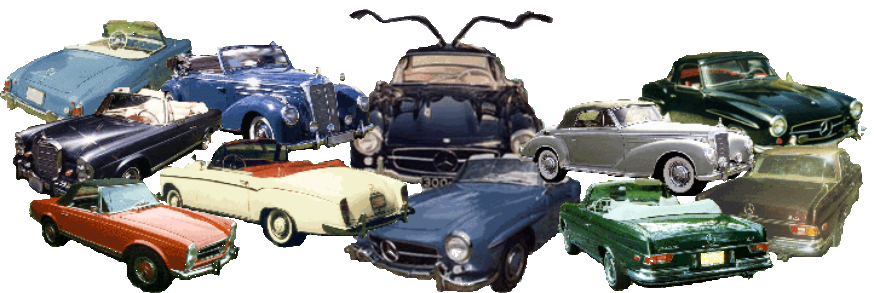

230SL / 250SL / 280SL 1961-1971

Introduction
Owning a Mercedes SL gives a person a real driving enjoyment and pride of ownership. When these cars
were first manufactured, Mercedes-Benz adhered to construction methods that resulted in a standard that
was the envy of the automotive industry. Every Mercedes-Benz model shared a build quality second to
none.
THE PAGODA-ITS HISTORY
The 230SL to the 280SL went into production in 1963. They
have a sleek, angular look. The nickname Pagoda (or
Pagode) comes from the typical roofline of the hardtop,
lower in the middle and higher at the edges. These cars
were sold in large numbers, so do not fall in love with the
first one you come across. Shop around, buy the best one
you can afford.
These cars are a big step forward over the 190 SL; they are
very reliable with great performance to match. The Pagodas have a more powerful, 6 cylinder engine, more
luxury and performance than the 190SL models, due to their mechanical fuel injection system. Although
originally they were supplied with 2 disc brakes and 2 drum brakes, starting with the 250SL forward, have
disc brakes all around. Later models were available with modern features such as:
•
Power steering
•
4-speed Automatic transmission
•
power assisted brakes
•
air conditioning
•
AM and FM radios
Because of this and their performance, they are very usable cars. They easily keep up with the cars of today
and have reasonable braking distances and safety features, such as a collapsible steering column and seat-
belts. You need to drive them a little more carefully than modern cars and keep a bit more distance due to
lesser braking distances but with their 150 HP acceleration means that you can easily keep up with modern
city and highway traffic.
Most people seem to prefer the 280 SL because they are more plush and are usually automatic. I prefer the
230 SL in a 4 speed with no options. It is a light, simple car that performs excellently.
These 230, 250, and 280 SL’s are built to drive. These cars need to be driven routinely, because the more
often they are used, the better they will perform. There is nothing worse than letting them sit.
Here is a chronology of changes (external only) made to the Pagoda's (US version only) during their
production:
230SL
August 1964
•
Wheel width increased from 5.5 to 6 inches.
November 1964
•
Spare tire well removed; tire mounted horizontally.
July 1965
•
Exhaust manifold changed from sheet steel to cast iron-exhaust headpipes were changed to match.
August 1965
•
Engine oil dipstick vent and filter omitted. Shape of horn ring changed from round to flattened top
segment
November 1965
•
Gear shift lever bent forward 55mm. Intake air heating coil added ahead of throttle housing.
December 1965
•
Form of crankcase vent line changed from 2 piece metal to 1 piece plastic (the mounting to the valve
cover was also changed from a hollow screw to a rubber sleeve.
250SL
January 1967 (Start of Production)
•
Coupe-only version with rear bench seat introduced
•
Engine fan with viscous drive made standard
•
Shape of cooling water tank changed from flat top to round top
•
Water pump made self lubricating
•
Metal loom for ignition wires omitted, replaced by plastic clips
•
Injection pump oil filter cap changed from metal to plastic
•
Seven main bearing engine adopted
•
Coolant capacity increased from 10.8 to 12.9 liters
•
Fuel tank capacity increased from 65 to 82 liters
•
Rear disc brakes introduced
•
Front anti-roll bar diameter decreased from 22 mm to 20 mm
•
Symbols added to turn signal switch
•
Instrument panel made in one piece instead of split
August 1967
•
Interior door handle, lock, window crank changed (the 1967 250SL had the same door hardware as
the 230SL; the 1968 250SL had the same door hardware as the 280SL.
•
Sunvisor mounting changed
•
Shape of horn ring changed again
•
Form of rear view and side view mirrors changed
•
Side reflectors added to fenders
•
Chrome discontinued on windshield wipers, horn ring, rear view mirror and door strikers
•
Face of ignition lock changed from convex to concave
•
Control knobs flattened
•
Steering wheel hub made collapsible, shape changed
•
Dash top padding rounded
•
Injection pump control shaft changed
•
Brake fluid level warning device added to master cylinder
280SL
January 1968
•
Chrome Strip under rear license plate omitted
•
Number plate moved from front firewall to front door jamb
•
Firewall insulation pad material changed from course to smooth
•
Mirror in passenger sun visor omitted
•
Hardtop front locking handles made separate
•
Solid door pockets changed to elastic
•
Interior material changed from wool boucle to synthetic tufted material
•
Heater and air vent levers made rubber instead of plastic
•
Legend plates added around light switch and heater controls
•
Emergency four-way flasher made standard
•
Floor covering changed from rubber mats to synthetic carpet
•
Headrests added to seats
•
Oil/Coolant-type cooler replaced by oil/air type cooler
•
Angle of oil filter housing changed
•
Covers for sub-frame mounts changed
•
Injection pump oil filter cap omitted
•
Separate intake air heating coil omitted, made integral with throttle housing
•
Rubber sleeve added to crankcase vent line
•
Diaphram-type clutch adopted
•
Wheel-covers made one piece, form changed after chassis number 000045
•
Steering relay lever changed, housing made self-lubricating
August 1969
•
Lights incorporated in side reflectors
•
Ignition/door/trunk/gas cap keys combined
•
Rear window heating element added, switch in parcel tray
•
Cold start solenoid omitted from injection pump
•
Wheel covers polished to satin
•
Form of wiper blades changed
April 1970
•
Optional rear axle ratios discontinued
August 1970
•
New colors added, existing colors changed
•
Number plate moved from front to rear of door jamb
•
Tail light colors changed, lens made separate from chrome
•
New seat fabrics
•
Power brake vacuum line made plastic, moisture trap omitted
•
Cooling water header tank made plastic
•
Form of engine oil filter cap changed from cast scew-on to stamped with bayonet-type mount
•
Shape of intake air box changed
•
Engine oil dipstick tube made longer, dipstick handle changed
•
Temperature sensors added to thermostat housing and cylinder head
•
Idle air housing shape changed
•
Distributor advance/retard speed sensors added
•
Ignition transistorized
•
Wheels changed to pierced with round holes



Production Numbers:
Production for the 230SL from March/July 1963 until January 1967 was:
230 SL chassis prefix is 113 042.
The engine prefix is 127 981.
1963:
1465 units
1964:
6,911 units
1965:
6,325 units
1966:
4,945 units
1967:
185 units
Total:
19,831 units
Production of the 250SL from November/December 1966 until January 1968 was:
250 SL chassis prefix is 113 043.
The engine prefix is 129 982
1966:
17 units
1967:
5,177 units
1968:
2 units
Total:
5,196 units
Production of the 280SL from November 1967/January 1968 until March 1971 was:
280 SL chassis prefix is 113 044.
The engine prefix is 130 983.
1967:
143 units
1968:
6,930 units
1969:
8,047 units
1970:
7,935 units
1971:
830 units
Total:
23,885 units
In total, therefore, 48,912 Pagodas were built.


Buying A 230 SL - 250 SL - 280 SL
Know what you're buying and what to look for and know what to avoid.
When these cars are well maintained and properly taken care of, they increase in value.
PLEASE READ THIS FIRST!
A car's value is determined by condition. Standard condition guidelines are as follows:
Excellent- As close to perfect original or a very well restored vehicle. Generally a body-off restoration, but
a well done body-on restoration that has been fully detailed may qualify. The vehicle is stunning to look
at. Everything works as new, all equipment is original, NOS or excellent quality reproductions. PLEASE
KEEP IN MIND THAT # 1 CARS ARE VERY RARE, AND ARE ORIGINAL RIGHT DOWN TO THE HOSE CLAMPS.
DO NOT ASSUME THAT JUST BECAUSE A CAR HAS A #1 ASKING PRICE, THAT IT IS IN # 1 CONDITION. MOST
CARS FOR SALE OUT THERE ARE LOW # 2 TO HIGH # 3 CARS.
Very Good- An extremely presentable vehicle showing minimal wear, or a well restored vehicle. Runs and
drives smooth and tight. Needs no mechanical or cosmetic work. All areas have been detailed. Beautiful
to look at but clearly not a # 1 vehicle.
Good- Presentable inside and out with some signs of wear. Not detailed but clean. Body should be
straight and solid with no rust-through anywhere. Shiny, attractive paint but may have evidence of minor
fading or checking or other imperfections. Runs and drives well but may need some minor mechanical or
cosmetic work. But it is useable and enjoyable as is.
Fair- Runs and drives ok but needs work throughout the vehicle. Body shows signs of wear or previous
restoration work. Any rust should be minimal and not in any structural areas. Cosmetics, body and
mechanicals all need work to some degree.
Poor- In need of complete restoration, but is complete and not a rust bucket beyond repair. May or may
not run but is not roadworthy.
These values are from Collector Car Market Review and are based on actual sales of vehicles,
not on asking prices of vehicles. Asking prices, and sales prices are very different.
Currently: (these are approximate values based on actual sales of vehicles.) Prices last updated Sept 2019
# 5
# 4
# 3
# 2
# 1
230 SL
$12,100.00
$25,300.00
$38,600.00
$60,000.00
$81,600.00
250 SL
$12,225.00
$25,800.00
$39,375.00
$61,200.00
$83,225.00
280 SL
$12,850.00
$32,600.00
$57,050.00
$85,000.00
$113,900.00
























Keep in mind that due to the high cost of restoration, mint examples of these cars can and
have sold for more than the prices quoted here.
The 280SL’s are more sought after because of their engine improvements and features. A good 250SL
with a 5-speed manual transmission is very rare and can therefore be expensive too. (add about 12% to
the above 250 SL values for a 5 speed manual car.)
Let's face it folks, these cars are 30 to 40 years old, they will show signs of maintenance and repair. They
were bought originally as daily drivers, and they were driven daily. It is rare that you will find an
unaltered, unrestored SL. But just because a car has had repairs does not indicate a bad car. You do want
to find one that has had a quality restoration.
Condition of a car CANNOT be determined by its location. Don't be fooled by a car's current geographical
location. Just because a car is in California today, does not mean that is where it started life.
Where to find the engine number and chassis number. You will find the engine number stamped on the
block on the left side rear just below the headgasket area. You should check the engine number of the
car. But don't be alarmed if there is no engine number on the car. Back when these cars were used as
daily transportation, engines were sometimes replaced. When a new engine came from the factory, it
came without a number. This was supposed to be stamped on at the dealership, however most times it
was not done. It is also possible to find a 280 SE sedan engine installed in an SL, as there were more
sedans than SL's. There is only a 10HP loss between a sedan and an SL engine. The average person more
often than not won't feel any difference.
Look at the car in general. Walk around the car several times looking at the gaps for the doors, trunk and
hood. Look at the general overall condition of the car.
Check the VIN number. You will find the VIN number on the right front frame rail under the air intake
hood. You will find the body plate under the
hood on the left side adjacent to the shock
tower. This plate will give useful information if
you know how to "decode" it. This was the
factory's "build plate" it gives the color code,
and option codes to which the car was built. DO
NOT confuse the numbers on this plate with the
VIN number (or chassis number)of the car. VIN
plates are also screwed or riveted to the car. On
the 230SL it is under the hood, on the right side
of the firewall. On the 250 SL, it is mounted in
the door on the A pillar post. On the 280 SL it is in the door mounted on the B pillar post. But because
these plates can be removed, and/or replaced, always check the one stamped into the right front frame
rail. VIN #'s are as follows:
The chassis prefix for a 230 SL is 113 042.
The engine prefix is 127 981
The chassis prefix for a 250 SL is 113 043.
The engine prefix is 129 982
The chassis prefix for a 280 SL is 113 044.
The engine prefix is 130 983

These cars are
extremely prone
to rust; except in
places such as the
hood, trunklid,
doors, and
tonneau cover for
the soft top
because they are
made out of
aluminum.
Sheetmetal is
readily available.
The entire floor
and frame
sections are being
reproduced with very good quality so rust is not impossible to fix but it is labor intensive, which equals
$$.
Check for rust in the following areas:
•
the trunk floors
•
the inner wheelbase panels in the rear
•
the rear frame rails at the lowest point just before the arch over the
rear axle
•
floors tend to get rusty in the corners where factory welds overlap
•
the rear body panel that holds the taillights, the bottom edge
•
under the seal for the trunk lid and the soft top lid cover
•
the area that connects the rear body panel to the rear fender
•
the rocker panels at the jack points, (this rust starts from the inside
and works its way out)
•
the front cross member that the front bumper bolts to
•
the headlights
•
the bracket which holds the light unit
•
the place where the front fender welds to the inner fender
•
Sometimes water drains and gets clogged and causes the firewall to
get rusty in spots where the water drains out.
Always put your intended purchase on a lift, up in the air to fully inspect (and poke if necessary) the
bottom undercarriage of the car. Any owner who won't allow this may have something to hide.
The best tool to use for checking the condition of body panels are your hands. There are a lot of cars out
there where the front sheet metal has been replaced. There are correct and incorrect ways of doing this!
First look for the spot welds on the inner lip of the fender. If you don't see a steady line of spot welds,
you need to do some further checking. Just because there are no spot welds, don't panic just yet. You
want to check for repairs that have been done correctly. Run your hand over this lip with your fingers
underneath. It should feel clean, smooth and perfectly "meshed" together. You will know when
something just does not feel right. Also, run your hands inside the wheel well opening to the underside
of the fender. Make sure you don't feel any overlapping metal under there. Sometimes in the interest of
saving time, instead of replacing the entire front fender, which requires the dash, wood, windshield, and
door be removed first, front fenders were cut and welded (with an overlap of metal)
This is an example of the INCORRECT method of
repair.
For the most part, the necessary parts are
interchangeable with sedans of the same number
designation so mechanical parts are plentiful. The
chrome trim items, headlights, taillights, etc. are
available but very costly. For example, a complete
front grill with the star will cost in the area of
$3100.00, so make sure the automobile you are
preparing to buy is complete. Ask the current owner for all documentation he has on the car. The more
information you have, the easier your purchase decision will be.

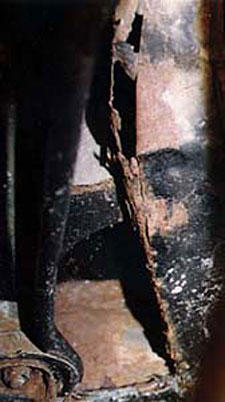
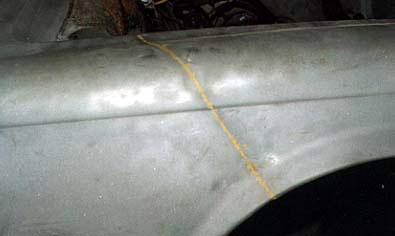
Technical Specifications 230SL
Engine Type:
6 cyl overhead camshaft (M127)
Bore and stroke:
82 x 72.8mm (3.23 x 2.87 in)
Displacement:
2,306 cc(140.7 cu in)
Power output:
150hp (DIN) @5500rpm, 110kW (170 hp SAE @5600rpm)
Compression ratio:
9.3:1
Torque:
20 mkg @ 4200 rpm (22mkg @4500 rpm 159 ft/lbs)
Fuel injection:
Bosch six plunger pump
Engine speed at 100km/hr:
3145 rpm
Gear ratios:
I. 4.42:1 Automatic I. 3.98:1
II. 2.28:1 II. 2.52:1
III. 1.53:1 III. 1.58:1
IV. 1.00:1 IV. 1.00:1
Rear axle ratio:
3.75; from Sept. 65: 3.69 or 3.92
Chassis:
unit frame and body
Suspension:
independent front, single joint swing axle rear, with coil springs
Brakes and area
disc, front; drum rear, servo assist, two circuit hydraulic,
252/230mm(9.96/9.06in)
Wheelbase:
2400mm (94.5 in)
Track front/rear:
1486/1487mm (58.5/58.5in)
Length:
4285mm (168.8in)
Width:
1760mm (69.2in)
Height:
1305mm (51.4in)
Ground clearance:
139mm (5.5in)
Tires:
185 HR 14 radial
Turning circle:
10.5 meters(34ft)
Steering type:
recirculating ball , 22.7:1( 4.1 turns); servo assisted 17.3:1(3.2 turns)
Weight:
roadster: 1300kg (2860lbs) -- coupe: 1380kg (3036lbs)
Maximum speed:
manual: 200km/hr (124mph/hr) -- automatic: 195km/hr(121 mph)
Acceleration:
manual: 11 sec 0-100km/hr -- automatic: 13 sec 0-100km/hr
Fuel consumption:
14 liter, super/100km (16.75mpg)
Fuel tank capacity:
65 liters(17.2 gallons)




























































Technical Specifications 250SL
Engine Type:
6 cyl overhead camshaft (M129)
Bore and stroke:
82 x 78.8mm(3.23 x 3.1in)
Displacement:
2496cc (152.3 cu in.)
Power output:
150 hp(DIN) @5500rpm, 110kW (170hp SAE @ 5600rpm)
Compression ratio:
9.3:1
Torque:
22 mkg @4200rpm(24 mkg @4500rpm 173.6 ft/lb)
Fuel injection:
Bosch six plunger pump
Engine speed at 100km/hr:
3425 rpm
Gear ratios:
I 4.05:1 Automatic- I. 3.98:1
II 2.23:1 II. 1.58:1
III 1.42:1 III. 1.58:1
IV 1.00:1 IV. 1.00:1
Rear axle ratio:
3.69
Chassis:
unit frame and body
Suspension:
independent front and rear, with coil springs, single joint swing
axle.
Brakes and area
disc, servo assist,two circuit hydraulic, 273/279mm(10.75/10.99 in)
Wheelbase:
2400mm(94.5in)
Track front/rear:
1486/1487mm(58.5/58.5in)
Length:
4285mm (168.8in)
Width:
1760mm (69.2in)
Height:
1305mm (51.4in)
Ground clearance:
139mm (5.5in)
Tires:
185 H 14 radial
Turning circle:
10.5 meters (34 ft)
Steering type:
Recirculating ball, 22.7:1 (4.1 turns); servo assisted, 17.3:1 (3.2
turns)
Weight:
roadster: 1300 kg (2860 lbs) ---- coupe: 1380 kg (3036 lbs)
Maximum speed:
manual: 200 km/hr (124mph) ---- automatic: 195km/hr (121 mph)
Acceleration:
manual: 11 sec 0-100 km/hr ---- automatic: 13 sec 0-100 km/hr
Fuel consumption:
14 liters, super/100 km (16.75 mpg)
Fuel tank capacity:
82 liters (21.7 gallons)




























































Technical Specifications 280SL
Engine Type:
6 cyl overhead camshaft (M 130)
Bore and stroke:
86.5 x 78.8mm (3.41 x 3.10in)
Displacement:
2778 cc (169.5 cu in)
Power output:
170 hp (DIN) @ 5700 rpm, 125kW (180 hp SAE hp @ 5700 rpm) or
180 hp (DIN) @ 5900 rpm (non-U.S.)
Compression ratio:
9.5:1
Torque:
24.5 mkg @ 4250 rpm( 26.7 mkg SAE @ 4500 rpm 193 ft/LB)
Fuel injection:
Bosch six plunger pump
Engine speed at 100km/hr:
3500 rpm
Gear ratios:
I. 4.05: Automatic I. 3.98:1
1 II 2.23:1 II. 2.52:1
III 1.42:1 III. 1.58:1
IV 1.00:1 IV 1.00:1
Rear axle ratio:
4.08 upon request: 3.92, 3.69
Chassis:
unit frame and body
Suspension:
independent front and rear, with coil springs, single joint swing
axle
Brakes and area
disc, servo assist, two circuit hydraulic, 273/279mm(10.75/10.99 in)
Wheelbase:
2400mm (94.4 in)
Track front/rear:
1486/1487mm (58.5/58.5 in)
Length:
4285mm (168.8 in)
Width:
1760mm (69.2 in)
Height:
1305mm (51.4 in)
Ground clearance:
139mm (5.5 in)
Tires:
185 H 14 radial
Turning circle:
10.5 meters (34 ft)
Steering type:
recirculating ball, servo assisted 17.2:1 (3.2 turns)
Weight:
roadster: 1340 kg (2948 lbs) : ---- coupe 1420 kg (3124 lbs.)
Maximum speed:
manual: 195 km/hr (121 mph)----automatic: 190 km/hr (118 mph)
Acceleration:
manual: 10 sec 0-100 km/hr ----automatic: 11 sec 0-100 km/hr
Fuel consumption:
14 liters, super/100km (16.75 mpg)
Fuel tank capacity:
82 liters (21.7 gallons)





























































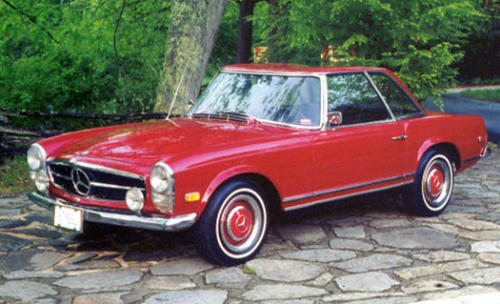


- 220 Cabriolet A and 220 Cabriolet B 1951-1955
- 300 -300b -300c - 300d Convertible Sedan 1951-1962
- 300S - 300Sc Cabriolet / Coupe / Roadster 1951-1958
- 300SL Gullwing and Roadster 1954-1962
- 190SL Roadsters 1955-1963
- 220S / 220SE Cabriolets & Coupes 1956-1960
- 300SE Cabriolets & Coupes 1962-1967
- 220SEb/250SE/280SE/280SE 3.5 Cabriolets & Coupes 1961-1971
- 230SL/250SL/280SL Roadsters 1963-1971


© Silver Star Restorations is an independent shop and is
not affiliated with Mercedes Benz of North American or
Daimler Benz AG


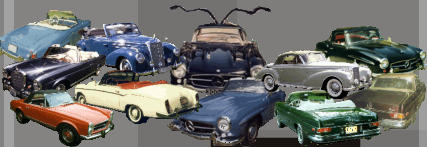
call Silver Star at 828-321-4268
230SL / 250SL / 280SL 1961-1971

Introduction
Owning a Mercedes SL gives a person a real driving enjoyment
and pride of ownership. When these cars were first manufactured,
Mercedes-Benz adhered to construction methods that resulted in
a standard that was the envy of the automotive industry. Every
Mercedes-Benz model shared a build quality second to none.
THE PAGODA-ITS HISTORY
The 230SL to the 280SL went
into production in 1963. They
have a sleek, angular look.
The nickname Pagoda (or
Pagode) comes from the
typical roofline of the
hardtop, lower in the middle
and higher at the edges. These cars were sold in large numbers,
so do not fall in love with the first one you come across. Shop
around, buy the best one you can afford.
These cars are a big step forward over the 190 SL; they are very
reliable with great performance to match. The Pagodas have a
more powerful, 6 cylinder engine, more luxury and performance
than the 190SL models, due to their mechanical fuel injection
system. Although originally they were supplied with 2 disc brakes
and 2 drum brakes, starting with the 250SL forward, have disc
brakes all around. Later models were available with modern
features such as:
•
Power steering
•
4-speed Automatic transmission
•
power assisted brakes
•
air conditioning
•
AM and FM radios
Because of this and their performance, they are very usable cars.
They easily keep up with the cars of today and have reasonable
braking distances and safety features, such as a collapsible
steering column and seat-belts. You need to drive them a little
more carefully than modern cars and keep a bit more distance
due to lesser braking distances but with their 150 HP acceleration
means that you can easily keep up with modern city and highway
traffic.
Most people seem to prefer the 280 SL because they are more
plush and are usually automatic. I prefer the 230 SL in a 4 speed
with no options. It is a light, simple car that performs excellently.
These 230, 250, and 280 SL’s are built to drive. These cars need to
be driven routinely, because the more often they are used, the
better they will perform. There is nothing worse than letting them
sit.
Here is a chronology of changes (external only) made to the
Pagoda's (US version only) during their production:
230SL
August 1964
•
Wheel width increased from 5.5 to 6 inches.
November 1964
•
Spare tire well removed; tire mounted horizontally.
July 1965
•
Exhaust manifold changed from sheet steel to cast iron-
exhaust headpipes were changed to match.
August 1965
•
Engine oil dipstick vent and filter omitted. Shape of horn ring
changed from round to flattened top segment
November 1965
•
Gear shift lever bent forward 55mm. Intake air heating coil added
ahead of throttle housing.
December 1965
•
Form of crankcase vent line changed from 2 piece metal to 1 piece
plastic (the mounting to the valve cover was also changed from a
hollow screw to a rubber sleeve.
250SL
January 1967 (Start of Production)
•
Coupe-only version with rear bench seat introduced
•
Engine fan with viscous drive made standard
•
Shape of cooling water tank changed from flat top to round top
•
Water pump made self lubricating
•
Metal loom for ignition wires omitted, replaced by plastic clips
•
Injection pump oil filter cap changed from metal to plastic
•
Seven main bearing engine adopted
•
Coolant capacity increased from 10.8 to 12.9 liters
•
Fuel tank capacity increased from 65 to 82 liters
•
Rear disc brakes introduced
•
Front anti-roll bar diameter decreased from 22 mm to 20 mm
•
Symbols added to turn signal switch
•
Instrument panel made in one piece instead of split
August 1967
•
Interior door handle, lock, window crank changed (the 1967
250SL had the same door hardware as the 230SL; the 1968
250SL had the same door hardware as the 280SL.
•
Sunvisor mounting changed
•
Shape of horn ring changed again
•
Form of rear view and side view mirrors changed
•
Side reflectors added to fenders
•
Chrome discontinued on windshield wipers, horn ring, rear view
mirror and door strikers
•
Face of ignition lock changed from convex to concave
•
Control knobs flattened
•
Steering wheel hub made collapsible, shape changed
•
Dash top padding rounded
•
Injection pump control shaft changed
•
Brake fluid level warning device added to master cylinder
280SL
January 1968
•
Chrome Strip under rear license plate omitted
•
Number plate moved from front firewall to front door jamb
•
Firewall insulation pad material changed from course to smooth
•
Mirror in passenger sun visor omitted
•
Hardtop front locking handles made separate
•
Solid door pockets changed to elastic
•
Interior material changed from wool boucle to synthetic tufted
material
•
Heater and air vent levers made rubber instead of plastic
•
Legend plates added around light switch and heater controls
•
Emergency four-way flasher made standard
•
Floor covering changed from rubber mats to synthetic carpet
•
Headrests added to seats
•
Oil/Coolant-type cooler replaced by oil/air type cooler
•
Angle of oil filter housing changed
•
Covers for sub-frame mounts changed
•
Injection pump oil filter cap omitted
•
Separate intake air heating coil omitted, made integral with
throttle housing
•
Rubber sleeve added to crankcase vent line
•
Diaphram-type clutch adopted
•
Wheel-covers made one piece, form changed after chassis
number 000045
•
Steering relay lever changed, housing made self-lubricating
August 1969
•
Lights incorporated in side reflectors
•
Ignition/door/trunk/gas cap keys combined
•
Rear window heating element added, switch in parcel tray
•
Cold start solenoid omitted from injection pump
•
Wheel covers polished to satin
•
Form of wiper blades changed
April 1970
•
Optional rear axle ratios discontinued
August 1970
•
New colors added, existing colors changed
•
Number plate moved from front to rear of door jamb
•
Tail light colors changed, lens made separate from chrome
•
New seat fabrics
•
Power brake vacuum line made plastic, moisture trap omitted
•
Cooling water header tank made plastic
•
Form of engine oil filter cap changed from cast scew-on to
stamped with bayonet-type mount
•
Shape of intake air box changed
•
Engine oil dipstick tube made longer, dipstick handle changed
•
Temperature sensors added to thermostat housing and cylinder
head
•
Idle air housing shape changed
•
Distributor advance/retard speed sensors added
•
Ignition transistorized
•
Wheels changed to pierced with round holes
Production Numbers:
Production for the 230SL from March/July 1963 until January 1967
was:
230 SL chassis prefix is 113 042.
The engine prefix is 127 981.
1963:
1465 units
1964:
6,911 units
1965:
6,325 units
1966:
4,945 units
1967:
185 units
Total:
19,831 units
Production of the 250SL from November/December 1966 until
January 1968 was:
250 SL chassis prefix is 113 043.
The engine prefix is 129 982
1966:
17 units
1967:
5,177 units
1968:
2 units
Total:
5,196 units
Production of the 280SL from November 1967/January 1968 until
March 1971 was:
280 SL chassis prefix is 113 044.
The engine prefix is 130 983.
1967:
143 units
1968:
6,930 units
1969:
8,047 units
1970:
7,935 units
1971:
830 units
Total:
23,885 units
In total, therefore, 48,912 Pagodas were built.
Buying A 230 SL - 250 SL - 280 SL
Know what you're buying and what to look for and know
what to avoid.
When these cars are well maintained and properly taken care of,
they increase in value.
PLEASE READ THIS FIRST!
A car's value is determined by condition. Standard condition
guidelines are as follows:
Excellent- As close to perfect original or a very well restored
vehicle. Generally a body-off restoration, but
a well done body-on restoration that has been fully detailed may
qualify. The vehicle is stunning to look at. Everything works as
new, all equipment is original, NOS or excellent quality
reproductions. PLEASE KEEP IN MIND THAT # 1 CARS ARE VERY
RARE, AND ARE ORIGINAL RIGHT DOWN TO THE HOSE CLAMPS.
DO NOT ASSUME THAT JUST BECAUSE A CAR HAS A #1 ASKING
PRICE, THAT IT IS IN # 1 CONDITION. MOST CARS FOR SALE OUT
THERE ARE LOW # 2 TO HIGH # 3 CARS.
Very Good- An extremely presentable vehicle showing minimal
wear, or a well restored vehicle. Runs and drives smooth and tight.
Needs no mechanical or cosmetic work. All areas have been
detailed. Beautiful to look at but clearly not a # 1 vehicle.
Good- Presentable inside and out with some signs of wear. Not
detailed but clean. Body should be straight and solid with no rust-
through anywhere. Shiny, attractive paint but may have evidence
of minor fading or checking or other imperfections. Runs and
drives well but may need some minor mechanical or cosmetic
work. But it is useable and enjoyable as is.
Fair- Runs and drives ok but needs work throughout the vehicle.
Body shows signs of wear or previous restoration work. Any rust
should be minimal and not in any structural areas. Cosmetics,
body and mechanicals all need work to some degree.
Poor- In need of complete restoration, but is complete and not a
rust bucket beyond repair. May or may not run but is not
roadworthy.
These values are from Collector Car Market Review and are
based on actual sales of vehicles, not on asking prices of
vehicles. Asking prices, and sales prices are very different.
Currently: (these are approximate values based on actual sales of vehicles.)
Prices last updated Sept 2019
Keep in mind that due to the high cost of restoration, mint
examples of these cars can and have sold for more than the
prices quoted here.
The 280SL’s are more sought after because of their engine
improvements and features. A good 250SL with a 5-speed manual
transmission is very rare and can therefore be expensive too. (add
about 12% to the above 250 SL values for a 5 speed manual car.)
Let's face it folks, these cars are 30 to 40 years old, they will show
signs of maintenance and repair. They were bought originally as
daily drivers, and they were driven daily. It is rare that you will find
an unaltered, unrestored SL. But just because a car has had
repairs does not indicate a bad car. You do want to find one that
has had a quality restoration.
Condition of a car CANNOT be determined by its location. Don't be
fooled by a car's current geographical location. Just because a car
is in California today, does not mean that is where it started life.
Where to find the engine number and chassis number. You will
find the engine number stamped on the block on the left side rear
just below the headgasket area. You should check the engine
number of the car. But don't be alarmed if there is no engine
number on the car. Back when these cars were used as daily
transportation, engines were sometimes replaced. When a new
engine came from the factory, it came without a number. This was
supposed to be stamped on at the dealership, however most
times it was not done. It is also possible to find a 280 SE sedan
engine installed in an SL, as there were more sedans than SL's.
There is only a 10HP loss between a sedan and an SL engine. The
average person more often than not won't feel any difference.
Look at the car in general. Walk around the car several times
looking at the gaps for the doors, trunk and hood. Look at the
general overall condition of the car.
Check the VIN number. You will find the VIN number on the right
front frame rail under
the air intake hood.
You will find the body
plate under the hood
on the left side
adjacent to the shock
tower. This plate will
give useful
information if you
know how to "decode" it. This was the factory's "build plate" it
gives the color code, and option codes to which the car was built.
DO NOT confuse the numbers on this plate with the VIN number
(or chassis number)of the car. VIN plates are also screwed or
riveted to the car. On the 230SL it is under the hood, on the right
side of the firewall. On the 250 SL, it is mounted in the door on the
A pillar post. On the 280 SL it is in the door mounted on the B
pillar post. But because these plates can be removed, and/or
replaced, always check the one stamped into the right front frame
rail. VIN #'s are as follows:
230 SL chassis prefix is 113 042.
engine prefix is 127 981
250 SL chassis prefix is 113 043.
engine prefix is 129 982
280 SL chassis prefix is 113 044.
engine prefix is 130 983
These cars are
extremely prone to
rust; except in places
such as the hood,
trunklid, doors, and
tonneau cover for the
soft top because they
are made out of
aluminum. Sheetmetal is readily available. The entire floor and
frame sections are being reproduced with very good quality so
rust is not impossible to fix but it is labor intensive, which equals
$$.
Check for rust in the following areas:
•
the trunk floors
•
the inner wheelbase panels in the rear
•
the rear frame rails at the lowest point just
before the arch over the rear axle
•
floors tend to get rusty in the corners
where factory welds overlap
•
the rear body panel that holds the taillights,
the bottom edge
•
under the seal for the trunk lid and the soft
top lid cover
•
the area that connects the rear body panel
to the rear fender
•
the rocker panels at the jack points, (this
rust starts from the inside and works its way out)
•
the front cross member that the front bumper bolts to
•
the headlights
•
the bracket which holds the light unit
•
the place where the front fender welds to the inner fender
•
Sometimes water drains and gets clogged and causes the
firewall to get rusty in spots where the water drains out.
Always put your intended purchase on a lift, up in the air to fully
inspect (and poke if necessary) the bottom undercarriage of the
car. Any owner who won't allow this may have something to hide.
The best tool to use for checking the condition of body panels are
your hands. There are a lot of cars out there where the front sheet
metal has been replaced. There are correct and incorrect ways of
doing this! First look for the spot welds on the inner lip of the
fender. If you don't see a steady line of spot welds, you need to do
some further checking. Just because there are no spot welds,
don't panic just yet. You want to check for repairs that have been
done correctly. Run your hand over this lip with your fingers
underneath. It should feel clean, smooth and perfectly "meshed"
together. You will know when something just does not feel right.
Also, run your hands inside the wheel well opening to the
underside of the fender. Make sure you don't feel any overlapping
metal under there. Sometimes in the interest of saving time,
instead of replacing the entire front fender, which requires the
dash, wood, windshield, and door be removed first, front fenders
were cut and welded (with an overlap of metal)
This is an example of the
INCORRECT method of repair.
For the most part, the
necessary parts are
interchangeable with sedans
of the same number
designation so mechanical parts are plentiful. The chrome trim
items, headlights, taillights, etc. are available but very costly. For
example, a complete front grill with the star will cost in the area of
$3100.00, so make sure the automobile you are preparing to buy
is complete. Ask the current owner for all documentation he has
on the car. The more information you have, the easier your
purchase decision will be.





# 5
# 4
# 3
# 2
# 1
230 SL
$12,100.00
$25,300.00
$38,600.00
$60,000.00
$81,600.00
250 SL
$12,225.00
$25,800.00
$39,375.00
$61,200.00
$83,225.00
280 SL
$12,850.00
$32,600.00
$57,050.00
$85,000.00
$113,900.00

























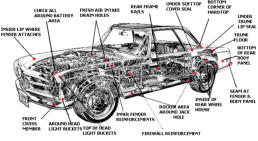
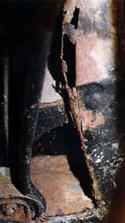

Technical Specifications 230SL
Engine Type:
6 cyl overhead camshaft (M127)
Bore and stroke:
82 x 72.8mm (3.23 x 2.87 in)
Displacement:
2,306 cc(140.7 cu in)
Power output:
150hp (DIN) @5500rpm, 110kW (170 hp SAE @5600rpm)
Compression ratio:
9.3:1
Torque:
20 mkg @ 4200 rpm (22mkg @4500 rpm 159 ft/lbs)
Fuel injection:
Bosch six plunger pump
Engine speed at 100km/hr:
3145 rpm
Gear ratios:
I. 4.42:1 Automatic I. 3.98:1
II. 2.28:1 II. 2.52:1
III. 1.53:1 III. 1.58:1
IV. 1.00:1 IV. 1.00:1
Rear axle ratio:
3.75; from Sept. 65: 3.69 or 3.92
Chassis:
unit frame and body
Suspension:
independent front, single joint swing axle rear, with coil springs
Brakes and area
disc, front; drum rear, servo assist, two circuit hydraulic,
252/230mm(9.96/9.06in)
Wheelbase:
2400mm (94.5 in)
Track front/rear:
1486/1487mm (58.5/58.5in)
Length:
4285mm (168.8in)
Width:
1760mm (69.2in)
Height:
1305mm (51.4in)
Ground clearance:
139mm (5.5in)
Tires:
185 HR 14 radial
Turning circle:
10.5 meters(34ft)
Steering type:
recirculating ball , 22.7:1( 4.1 turns); servo assisted 17.3:1(3.2 turns)
Weight:
roadster: 1300kg (2860lbs) -- coupe: 1380kg (3036lbs)
Maximum speed:
manual: 200km/hr (124mph/hr) -- automatic: 195km/hr(121 mph)
Acceleration:
manual: 11 sec 0-100km/hr -- automatic: 13 sec 0-100km/hr
Fuel consumption:
14 liter, super/100km (16.75mpg)
Fuel tank capacity:
65 liters(17.2 gallons)




























































Technical Specifications 250SL
Engine Type:
6 cyl overhead camshaft (M129)
Bore and stroke:
82 x 78.8mm(3.23 x 3.1in)
Displacement:
2496cc (152.3 cu in.)
Power output:
150 hp(DIN) @5500rpm, 110kW (170hp SAE @ 5600rpm)
Compression ratio:
9.3:1
Torque:
22 mkg @4200rpm(24 mkg @4500rpm 173.6 ft/lb)
Fuel injection:
Bosch six plunger pump
Engine speed at 100km/hr:
3425 rpm
Gear ratios:
I 4.05:1 Automatic- I. 3.98:1
II 2.23:1 II. 1.58:1
III 1.42:1 III. 1.58:1
IV 1.00:1 IV. 1.00:1
Rear axle ratio:
3.69
Chassis:
unit frame and body
Suspension:
independent front and rear, with coil springs, single joint swing
axle.
Brakes and area
disc, servo assist,two circuit hydraulic, 273/279mm(10.75/10.99 in)
Wheelbase:
2400mm(94.5in)
Track front/rear:
1486/1487mm(58.5/58.5in)
Length:
4285mm (168.8in)
Width:
1760mm (69.2in)
Height:
1305mm (51.4in)
Ground clearance:
139mm (5.5in)
Tires:
185 H 14 radial
Turning circle:
10.5 meters (34 ft)
Steering type:
Recirculating ball, 22.7:1 (4.1 turns); servo assisted, 17.3:1 (3.2
turns)
Weight:
roadster: 1300 kg (2860 lbs) ---- coupe: 1380 kg (3036 lbs)
Maximum speed:
manual: 200 km/hr (124mph) ---- automatic: 195km/hr (121 mph)
Acceleration:
manual: 11 sec 0-100 km/hr ---- automatic: 13 sec 0-100 km/hr
Fuel consumption:
14 liters, super/100 km (16.75 mpg)
Fuel tank capacity:
82 liters (21.7 gallons)




























































Technical Specifications 280SL
Engine Type:
6 cyl overhead camshaft (M 130)
Bore and stroke:
86.5 x 78.8mm (3.41 x 3.10in)
Displacement:
2778 cc (169.5 cu in)
Power output:
170 hp (DIN) @ 5700 rpm, 125kW (180 hp SAE hp @ 5700 rpm) or
180 hp (DIN) @ 5900 rpm (non-U.S.)
Compression ratio:
9.5:1
Torque:
24.5 mkg @ 4250 rpm( 26.7 mkg SAE @ 4500 rpm 193 ft/LB)
Fuel injection:
Bosch six plunger pump
Engine speed at 100km/hr:
3500 rpm
Gear ratios:
I. 4.05: Automatic I. 3.98:1
1 II 2.23:1 II. 2.52:1
III 1.42:1 III. 1.58:1
IV 1.00:1 IV 1.00:1
Rear axle ratio:
4.08 upon request: 3.92, 3.69
Chassis:
unit frame and body
Suspension:
independent front and rear, with coil springs, single joint swing
axle
Brakes and area
disc, servo assist, two circuit hydraulic, 273/279mm(10.75/10.99 in)
Wheelbase:
2400mm (94.4 in)
Track front/rear:
1486/1487mm (58.5/58.5 in)
Length:
4285mm (168.8 in)
Width:
1760mm (69.2 in)
Height:
1305mm (51.4 in)
Ground clearance:
139mm (5.5 in)
Tires:
185 H 14 radial
Turning circle:
10.5 meters (34 ft)
Steering type:
recirculating ball, servo assisted 17.2:1 (3.2 turns)
Weight:
roadster: 1340 kg (2948 lbs) : ---- coupe 1420 kg (3124 lbs.)
Maximum speed:
manual: 195 km/hr (121 mph)----automatic: 190 km/hr (118 mph)
Acceleration:
manual: 10 sec 0-100 km/hr ----automatic: 11 sec 0-100 km/hr
Fuel consumption:
14 liters, super/100km (16.75 mpg)
Fuel tank capacity:
82 liters (21.7 gallons)




























































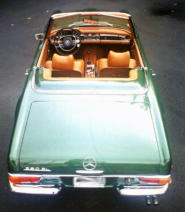
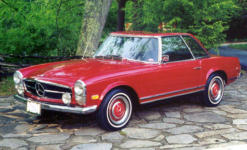


- 220 Cabriolet A and 220 Cabriolet B 1951-1955
- 300 -300b -300c - 300d Convertible Sedan 1951-1962
- 300S - 300Sc Cabriolet / Coupe / Roadster 1951-1958
- 300SL Gullwing and Roadster 1954-1962
- 190SL Roadsters 1955-1963
- 220S / 220SE Cabriolets & Coupes 1956-1960
- 300SE Cabriolets & Coupes 1962-1967
- 220SEb/250SE/280SE/280SE 3.5 Cabriolets & Coupes 1961-1971
- 230SL/250SL/280SL Roadsters 1963-1971













